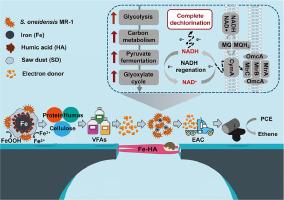Biogenic amorphous FeOOH activated additional intracellular electron flow pathways for accelerating reductive dechlorination of tetrachloroethylene
IF 12.4
1区 环境科学与生态学
Q1 ENGINEERING, ENVIRONMENTAL
引用次数: 0
Abstract
Dissimilatory iron-reducing bacteria (DIRB) with extracellular electron transfer (EET) capabilities have shown significant potential for bioremediating halogenated hydrocarbon contaminated sites rich in iron and humic substances. However, the role and microbial molecular mechanisms of iron-humic acid (Fe-HA) complexes in the reductive dehalogenation process of DIRB remains inadequately elucidated. In this study, we developed a sustainable carbon cycling approach using Fe-HA complexes to modulate the electron flux from sawdust (SD), enabling almost complete reductive dechlorination by most DIRB (e.g., Shewanella oneidensis MR-1) that lack complex iron-sulfur molybdo enzymes. The SD-Fe-HA/MR-1 system achieved a 96.52% removal efficiency of tetrachloroethylene (PCE) at concentrations up to 250 μmol/L within 60 days. Material characterization revealed that DIRB facilitated the hydrolysis of macromolecular carbon sources by inducing the formation of amorphous ferrihydrite (FeOOH) in Fe-HA complexes. More importantly, the bioavailable FeOOH activated additional intracellular electron flow pathways, increasing the activity of potential dehalogenases. Transcriptome further highlight the innovative role of biogenic amorphous FeOOH in integrating intracellular redox metabolism with extracellular charge exchange to facilitate reductive dechlorination in DIRB. These findings provide novel insights into accelerating reductive dechlorination in-situ contaminated sites lacking obligate dehalogenating bacteria.

生物非晶态 FeOOH 激活额外的细胞内电子流途径,加速四氯乙烯的还原脱氯反应
具有细胞外电子传递(EET)能力的溶铁还原细菌(DIRB)在对富含铁和腐殖质的卤代烃污染场地进行生物修复方面显示出巨大的潜力。然而,铁-腐殖酸(Fe-HA)复合物在 DIRB 还原脱卤过程中的作用和微生物分子机制仍未得到充分阐明。在这项研究中,我们开发了一种可持续的碳循环方法,利用铁-腐植酸复合物来调节锯末(SD)中的电子通量,使大多数缺乏铁硫钼多复合酶的 DIRB(如 Shewanella oneidensis MR-1)几乎能够完全还原脱氯。在 60 天内,SD-Fe-HA/MR-1 系统对浓度高达 250 μmol/L 的四氯乙烯(PCE)的去除率达到 96.52%。材料表征显示,DIRB 通过诱导 Fe-HA 复合物中无定形铁水物(FeOOH)的形成,促进了大分子碳源的水解。更重要的是,生物可利用的 FeOOH 激活了额外的细胞内电子流途径,提高了潜在脱卤酶的活性。转录组进一步凸显了生物性无定形 FeOOH 在整合细胞内氧化还原代谢与细胞外电荷交换以促进 DIRB 中还原脱氯过程中的创新作用。这些发现为在缺乏强制性脱卤细菌的污染场地加速还原脱氯提供了新的见解。
本文章由计算机程序翻译,如有差异,请以英文原文为准。
求助全文
约1分钟内获得全文
求助全文
来源期刊

Water Research
环境科学-工程:环境
CiteScore
20.80
自引率
9.40%
发文量
1307
审稿时长
38 days
期刊介绍:
Water Research, along with its open access companion journal Water Research X, serves as a platform for publishing original research papers covering various aspects of the science and technology related to the anthropogenic water cycle, water quality, and its management worldwide. The audience targeted by the journal comprises biologists, chemical engineers, chemists, civil engineers, environmental engineers, limnologists, and microbiologists. The scope of the journal include:
•Treatment processes for water and wastewaters (municipal, agricultural, industrial, and on-site treatment), including resource recovery and residuals management;
•Urban hydrology including sewer systems, stormwater management, and green infrastructure;
•Drinking water treatment and distribution;
•Potable and non-potable water reuse;
•Sanitation, public health, and risk assessment;
•Anaerobic digestion, solid and hazardous waste management, including source characterization and the effects and control of leachates and gaseous emissions;
•Contaminants (chemical, microbial, anthropogenic particles such as nanoparticles or microplastics) and related water quality sensing, monitoring, fate, and assessment;
•Anthropogenic impacts on inland, tidal, coastal and urban waters, focusing on surface and ground waters, and point and non-point sources of pollution;
•Environmental restoration, linked to surface water, groundwater and groundwater remediation;
•Analysis of the interfaces between sediments and water, and between water and atmosphere, focusing specifically on anthropogenic impacts;
•Mathematical modelling, systems analysis, machine learning, and beneficial use of big data related to the anthropogenic water cycle;
•Socio-economic, policy, and regulations studies.
文献相关原料
公司名称
产品信息
阿拉丁
diatomite
 求助内容:
求助内容: 应助结果提醒方式:
应助结果提醒方式:


